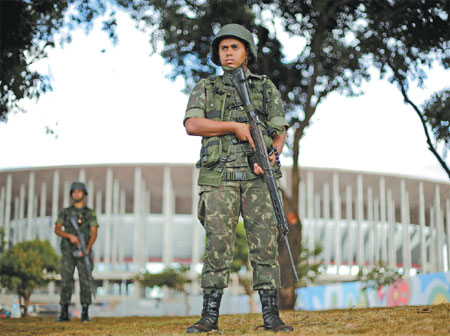Brazil has changed, but Cup quandaries have not
Updated: 2014-06-08 07:35
By Reuters in Sao Paulo(China Daily)
|
|||||||||
Today's Brazil is a completely different country from the one that hosted the World Cup in 1950, but some things have hardly changed - even after 64 years.
Now as then, the fans' desperation to see games is matched only by the authorities' inability to build stadiums on time and under budget.
This year's tournament, which opens on June 12, will be held across 12 cities at a cost of at least $12.32 billion - almost a third of which is being spent on luxurious new or modernized stadiums.
Three of the 12 venues - in Brasilia, Sao Paulo and the Maracana in Rio de Janeiro - will cost more than $700 million each, and yet only two of the 12 were delivered on time.
The 1950 matches were played at just six grounds, including the Maracana, which was built in less than two years at a cost that was a fraction of the retrofit, said Diego Salgado, co-author of the book, 1950: The Price of a World Cup.
More than 90 percent of the entire budget for the 1950 tournament went on that one stadium, Salgado said. Authorities delayed years before starting construction work and then went over budget.
"It's been 64 years but we're seeing a rerun of what happened back then," Salgado said.
"The costs rose because it was urgent. The first game to be played at the Maracana was played seven days before the first game of the World Cup."
Brazil had not yet won soccer's greatest trophy in 1950 but has since established itself as the dominant power, winning the World Cup a record five times. Fans the world over celebrated in 2007 when the South American giant won the right to host the 2014 tournament.
Brazil's politicians vowed it would be a golden opportunity for the developing nation to add much needed infrastructure but, with days to go until the opening match, much of the promised works have not materialized.
In 1950, as now, Brazil saw the World Cup as a chance to show off to the world, said David Goldblatt, author of the book, Futebol Nation: The Story of Brazil through Soccer.
The country was modernizing quickly and seeking more of a global presence. And, then as now, there were elections taking place following the tournament with politicians seeing it as a chance to show off.
While Brazil's traditionally chaotic planning has embarrassed even Cup backers like former striker Ronaldo, who has two winners' medals, it has not affected demand.
About three million tickets have been sold for this year's tournament and close to 800,000 people are expected to come from abroad to watch matches.
They will see a spectacle that is unrecognizable to the one held here more than half a century ago.
Back then only two of the grounds were built specially for the tournament and they were considered progressive, fitting monuments both to the game that had taken Brazil by storm and to the country's pretensions of grandeur.
The Maracana was finished so late that English referee Arthur Ellis reported plaster falling from the walls when a 21-gun salute went off and a Yugoslav player cut his head on an exposed steel beam, Goldblatt said.
"On the other hand I look at the Maracana and it was a much more generous vision than the vision today," he said. "As well as the football stadium they built other stuff. The athletics track and swimming pool were intended for public use and the school as well."
And although only 13 teams took part, compared to 32 today, interest was high. Soccer was already a religion in Brazil and the average attendance for the 22 games was 47,511, still more than at all but seven of the 19 World Cups.
Today the tournament is massive. There were more than 800 qualifying matches for 2014, compared to just 27 for the 1950 Cup.
FIFA has budgeted for $3.8 billion in revenues during the period 2011-14, with about 85-90 percent of that coming from the World Cup, according to official figures.
Roughly 60 percent is from TV deals and the rest comes from sponsors, licensing and hospitality rights, FIFA said.
In 1950 there were no major sponsors of any kind and no live TV coverage because outside broadcasts had not been invented. The Jules Rimet Trophy was placed in the window of a Rio jewelry shop for fans to see.
This year the original FIFA World Cup Trophy - it has no name but it is trademarked - will spend 267 days traveling to 88 different countries so fans can catch a glimpse of it behind a glass screen.
Perhaps the biggest similarity between the two tournaments is the home nation's desire to win. In 1950, Brazil fell to Uruguay at the final hurdle and the defeat was so catastrophic that people are still talking about it.
They are hoping for a different ending this time.
"There's been a black cloud hanging over the Maracana ever since that game," said Amarildo, who played for Brazil in the 1962 World Cup and remembers the 1950 defeat as a nine-year old boy.
"The only way it will be lifted is if we win the final this time."
|
A Brazilian soldier stands guard during a security drill for the upcoming World Cup along the streets of Brasilia last week. Ueslei Marcelino / Reuters |
(China Daily 06/08/2014 page12)
